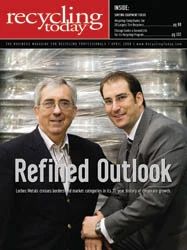Since the origin of the scrap metal recycling industry, suppliers and consumers have sought a means to describe various scrap grades and to determine their conformance to a specification. To date, the predominant method used to evaluate a shipment of scrap metal has been the highly technical process termed "visual inspection."
In fact, scrap specifications themselves are often written in an attempt to qualify a heterogeneous material by describing what should not be included to the extent that consumers can predict its results in use. To the credit of both suppliers and consumers, the results of this subjective and variable process have worked reasonably well for many years.
BEYOND THE SURFACEFor the last six years, Gamma-Tech LLC, Dayton, Ky., has been slowly adding science and technology to this equation for ferrous, and most recently aluminum, shredded scrap. This technology, known as the CrossBelt Recycled Metal (CB-RM) analyzer, uses the proven science of prompt-gamma-neutron-activation analysis (PGNAA). PGNAA is a non-destructive technique for simultaneously determining the presence and amount of many elements in samples of various sizes.
The CB-RM and similar bulk metal analyzers provide the means to report the composite (not surface-oriented) elemental analysis of scrap grades on a real-time basis. Suppliers will know the chemistry of what they are producing and can in turn report this information to their consumers. Consumers can then use the chemistry to accept and optimally value the material in their processes.
NEW DEVELOPMENTSThe technology employed by the CB-RM has been used for more than 20 years in the coal and cement industries, where there are more than 400
Recycling Today At the time, Alan Crouch, then president of River Metals Recycling (RMR), said the addition of the CrossBelt Recycled Metal Analyzer (CB RM), distributed by Gamma-Tech LLC, Dayton, Ky., had not slowed down the company’s operations. "The processing rate for the machine ranges up to 200 or 300 tons per hour," Crouch told Recycling Today. "It will not impede the production of your shredder." Crouch also noted that River Metals’ staff was actually creating the product. It’s up to the RMR staff to add the metal units needed to create the desired composition of the end product. The analyzer’s role was to confirm the chemical composition of the final product, he said. "Without the bulk analyzer," he told Recycling Today, "there is no way to tell what the copper level is. You can try to keep it to a minimum, but you cannot predict what the final chemistry will be." – DeAnne Toto
units installed worldwide.
Process Control
Thermo Fisher Scientific, Waltham, Mass., manufactures the CB-RM, which is exclusively distributed in the metals and recycling industries by Gamma-Tech LLC. There are currently 15 (two of which are outside of North America) CB-RM units installed in-line with ferrous and nonferrous shredding operations.
Bulk metal analyzers such as the CB-RM report the percent of copper, nickel, chromium and manganese in shredded ferrous product.
For shredded aluminum, the technology also is capable of reporting the percentage of iron, silicon, zinc, magnesium and titanium in the material’s composition.
This year Gamma-Tech will be releasing the Omni-4 model of the CrossBelt Recycled Metal analyzer. As the third-generation of the CB-RM, the Omni-4 will have double the number of detectors and faster data processing speeds, both of which will improve its performance. The Omni-4 also will include enhanced system diagnostics.
Bulk metal analyzers allow suppliers to meet the needs of their consumers by controlling their processes and reacting to changes in the chemistry of their shredded material without sacrificing their productivity. Such analyzers can handle a variety of production speeds. For instance, CB-RM installations currently process from 50 to 350 tons per hour with a cost of approximately $1.35 per ton to $3 per ton for average-size ferrous and aluminum shredding operations, respectively.
A NEW LANGUAGEThe technology used by bulk metal analyzers provides the means to convert heterogeneous obsolete scrap into a manufactured product with a "known" analysis, reduced variability and, in most cases, higher metallurgical quality in light of less contamination.
Suppliers and consumers now have a common science-based language to describe scrap that is not related to its physical appearance, but that is related to its metallurgical value.
Using bulk metal analyzers, recyclers can make custom grades of products for specific consumers to address the ever-changing world of their production requirements and raw material markets.
Gamma-Tech can supply both sides of this market with process and product metallurgical support to help maximize the value of the technology.
Technology, with its accompanying productivity improvements, is making its way into all aspects of our lives, and the scrap industry and its customers are no different. Whether it is personal digital devices that allow us to stay in touch with the world when we’re away from our desks, high-speed computer programs that monitor and react to changes on Wall Street or bulk metal analyzers that quantify the quality of ferrous and aluminum scrap, modern technology provides knowledge.
In the case of bulk metal analyzers, this knowledge allows industries to improve their respective processes, control the quality of their products and create real value for their consumers.
The author is president of Gamma-Tech LLC and can be reached at dpflaum@gammatech.us.

Explore the April 2008 Issue
Check out more from this issue and find your next story to read.
Latest from Recycling Today
- BMW Group, Encory launch 'direct recycling’ of batteries
- Loom Carbon, RTI International partner to scale textile recycling technology
- Goodwill Industries of West Michigan, American Glass Mosaics partner to divert glass from landfill
- CARI forms federal advocacy partnership
- Monthly packaging papers shipments down in November
- STEEL Act aims to enhance trade enforcement to prevent dumping of steel in the US
- San Francisco schools introduce compostable lunch trays
- Aduro graduates from Shell GameChanger program





